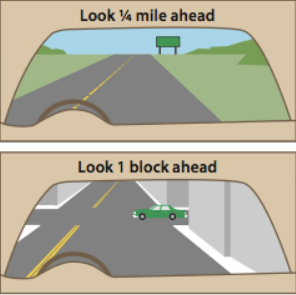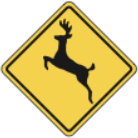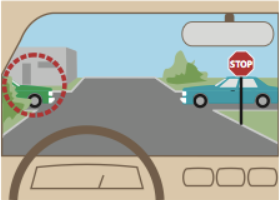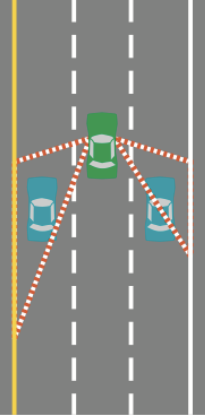Session 20 – Seeing Well
SEEING WELL
Most of what you do in driving depends on what you see. To be a good driver, you need to see well. The single biggest contributor to crashes is failing to see what is happening. You must look down the road, to the sides and behind your vehicle, and be alert for unexpected events. At night and at other times when it’s hard to see and be seen, you must use your headlights.
You must be alert to what is going on around you. Many crashes occur because drivers do not pay enough attention to their driving. Do not take your eyes off the road for more than a few seconds at any one time. If you need to look at a map, pull safely off the road before you try to look at it. Do not try to read the map while you are driving.
Remember that cars and trucks are not the only “users” of the road. In many crashes with motorcycles, bicycles and pedestrians, drivers say they looked but did not see them.
Never underestimate the size or speed of an approaching truck or bus. Because of their large size, they often appear to be traveling at a slower speed than they actually are. Give them extra room.
Do not slow down just to look at a crash, someone getting a ticket or other roadside activity. This could cause you to be in a crash. If you take your eyes off the road to look at something, you could run into a vehicle ahead that has slowed or stopped. When you pass these roadside activities, keep your eyes on the road and get past them as soon and as safely as you can.
Scanning
To be a good driver, you must know what is happening around your vehicle. You must look ahead, to the sides and behind the vehicle. Scanning helps you see problems ahead, vehicles and people that may be in the road by the time you reach them, signs warning of problems ahead and signs giving you directions.
Look ahead. In order to avoid last-minute braking or the need to turn, you should look well down the road. By looking well ahead and being ready to stop or change lanes if needed, you can drive more safely, save on fuel, help keep traffic moving at a steady pace and allow yourself time to see better around your vehicle and alongside the road. Looking well down the road will also help you to steer straighter with less weaving. Safer drivers tend to look 10 to 15 seconds ahead of their vehicle. How far is this? It is the distance your vehicle will travel in 10 to 15 seconds.

In the city, 10 to 15 seconds is about one block. When you drive in city traffic, you should try to look at least one block ahead. On the highway, 10 to 15 seconds is about 4 city blocks, or a quarter of a mile.
How do you know how many seconds you are looking ahead? Here is how to figure how far ahead you are looking.
- Find a non-moving object like a sign or tree near the road about as far ahead as you are looking.
- Start counting: one-thousand-one, one-thousand-two, one-thousand-three, etc., until you reach the object.
- The number of seconds you have counted is the number of seconds you were looking ahead.
You can be a safer driver by looking well ahead. You can reduce the need to stop or turn quickly. The less you have to stop or turn quickly, the less likely you are to run into someone or have someone run into you.
By looking well ahead, you can save on fuel. Every time you have to stop quickly, it takes time and fuel to get your vehicle back up to speed. Drivers who look ahead can slow down gradually, or change lanes to avoid unnecessary braking that leads to lower miles-per-gallon.
Traffic flows more smoothly when everyone looks well ahead. Making driving changes before the last moment gives drivers behind you more time to react. The earlier you act, the less often someone behind you has to quickly react to your vehicle. By seeing needed driving changes early, you can drive more safely and that helps drivers behind you drive more safely, too. It also keeps traffic moving at a steady pace.
Look to the sides. Because other vehicles or pedestrians may cross or enter your path anytime, you should look to the sides to make sure no one is coming. This is especially true at intersections and railroad crossings.
Watch Out for Deer
The number and severity of collisions between motor vehicles and deer continues to increase. In fact, deer are the third most commonly struck object in Wisconsin, with other vehicles and fixed objects topping the list. However, there are some things you can do to reduce your risk of hitting a deer. Be especially alert for deer in October and November, the months with the highest number of car/deer crashes.

- Deer are most active in the dusk to dawn hours, so you should be especially alert while driving during those times. Scan the sides of the road to watch for the reflection
of your vehicle headlights in the eyes of deer. - If you see such a reflection on the side of the road, slow down. Blow the horn and be ready to stop. Always watch for more than one deer.
- While deer crossings typically occur in rural settings, deer sometimes wander into towns or even cities. Deer may cross anywhere, anytime.

Intersections: Intersections are any place where traffic merges or crosses. They include cross streets, side streets, driveways and shopping center or parking lot entrances, and railroad crossings. Before you enter an intersection, look to both the left and right for approaching vehicles and/or crossing pedestrians. If stopped, look to both the left and right just before you start moving. Look across the intersection before you start to move to make sure the path is clear all the way through the intersection, and that you will not block it if you have to stop. Then look left again.
Do not rely on traffic signals or signs to tell you that no one will be crossing in front of you. Some drivers do not obey, or may not notice, traffic signals or signs. At an intersection, look left and right, even if other traffic has a red light or a stop sign. This is especially important just after the light has turned green. This is when people on the cross street are most likely to hurry through the intersection before the light changes to red. Individuals who have been drinking and reckless or aggressive drivers may also run red lights.
Make sure you can clearly see crossing traffic before entering a controlled intersection (one with a stop sign or light). If you are stopped and your view of a cross street is blocked, slowly move ahead and stop again before entering the intersection. Check for cross traffic and pedestrians before proceeding.

If you are coming to an uncontrolled intersection, slow down so you can safely see up and down the cross street before crossing it. If your view is blocked at an uncontrolled intersection, be prepared to brake, if needed, as you slowly edge forward until you can see up and down the cross street. By slowly moving forward, crossing drivers can see the front of your vehicle and it gives them a chance to slow down and warn you that they are approaching.
Whenever there is a lot of activity along the side of the road, there is a good chance that someone will cross or enter the road.
Therefore, it is very important to look to the sides when you are near shopping centers and parking lots, construction areas, busy sidewalks, playgrounds and schoolyards.
Railroad crossings: As you approach any railroad crossing slow down and look up and down the tracks to make sure a train is not coming. Do not assume a train is not coming even if you have never seen one at that crossing before. Assuming a train is not coming is one of the leading causes of fatalities at railroad crossings. Make sure there is room for your vehicle on the far side before you cross the tracks.
At crossings with more than one track, wait until the passing train is well down the track before starting to cross. Another train may be hidden by the one that just passed.
Be especially watchful if you are following a bicyclist or motorcyclist across railroad tracks. They may swerve in order to cross the tracks at a 90° angle so their tires don’t get caught in the tracks.
Look behind: Besides watching traffic ahead of you, you must check traffic behind you. Check your mirrors every 6 to 8 seconds. You will need to check more often than that when traffic is heavy. This is the only way you will know if someone is following too closely or coming up too fast, and it will give you time to do something about it. It is very important to look for vehicles behind you when you change lanes, slow down, back up, or are driving down a long or steep hill.
When going down a long or steep hill, check your mirrors frequently. Vehicles often build up speed going down a steep grade. Be alert for large trucks and buses behind you that may be going too fast.
When changing lanes: Whenever you want to change lanes, you must check to make sure there are no vehicles in the lane you want to enter.
This means you must check for traffic to the side and behind your vehicle before you change lanes. Changing lanes includes changing from one lane to another, merging onto a roadway from an entrance ramp, and entering the roadway from the curb or shoulder. When changing lanes, you should:
Look in your rear view and side mirrors. Make sure there are no vehicles in the lane you want to enter. Make sure nobody is about to pass you.
Look over your shoulder in the direction you plan to move. Be sure no one is near the rear corners of your vehicle. These areas are called “blind spots” because you cannot see them through your mirrors. To see vehicles in your blind spot, you need to turn your head and look.

Check quickly: Do not take your eyes off the road ahead for more than an instant. Traffic ahead of you could stop suddenly while you are looking to the sides, rear or over your shoulder. Also, use your mirrors to check traffic while you are preparing to merge or pull onto the roadway. This way you can keep an eye on vehicles ahead of you at the same time. Just before you change lanes, check over your shoulder for traffic in your blind spot. You must keep track of what traffic is doing in front of you and in the lane you are entering.
Check the far lane, if there is one, as someone in that lane may be planning to move into the same lane you want to enter.
Check for other road users. Remember, there are other road users such as motorcycles, bicycles and pedestrians that are harder to see than cars and trucks. Children may run or ride out into the road without looking. Be especially alert when you are entering the roadway from the curb or driveway. Signal before you change direction.

When you slow down: You must check behind your vehicle whenever you slow down. This is very important when you slow down quickly or at points where a driver following you would not expect you to slow down, such as private driveways or parking spaces.
When you back up: It is hard for you to see behind your vehicle. Try to do as little backing as possible. Where backing is necessary, here are some hints to help you back your vehicle safely.
- Check behind your vehicle before you get in it. Children or small objects often cannot be seen from the driver’s seat. Do not depend on your rearview or side mirrors to see things around you. You should turn and look directly through the rear window.
- Back slowly: no faster than a slow walk. Your vehicle is much harder to steer while you are backing. Whenever possible, use a person outside the vehicle to help you back.
- When you are done backing up, scan around you, left and right, before moving into traffic.
Use Your Lights
It is much harder to see at night. Here are some things you can do that will help you see better:
Use your high beams whenever there are no oncoming vehicles. High beams let you see twice as far as low beams. It is important to use high beams on unfamiliar roads, in construction areas, or where there may be people along the side of the road.
Dim your high beams whenever you come within 500 feet (about a one block distance) of an oncoming vehicle.
Use your low beams when you are closer than 500 feet behind another vehicle or when in heavy traffic.

Use the low beams in fog or when it is snowing or raining hard. Light from high beams will reflect back, causing glare and making it more difficult to see ahead. Some vehicles have fog lights that you should also use under these conditions. Do not drive at any time with only your parking lights on.
Parking lights are for parking only.
If a driver approaching you fails to dim their headlights, you may flash your high beams to let them know. If they still don’t dim the lights, look toward the right side of the road. This will keep you from being blinded by the other vehicle’s headlights and will allow you to see enough of the edge of the road to stay on course until the other vehicle has passed.
Wisconsin Law: You must have your headlights on when driving from half an hour after sunset to half an hour before sunrise, and at any other time you cannot see a vehicle or person on the roadway at a distance of 500 feet.
